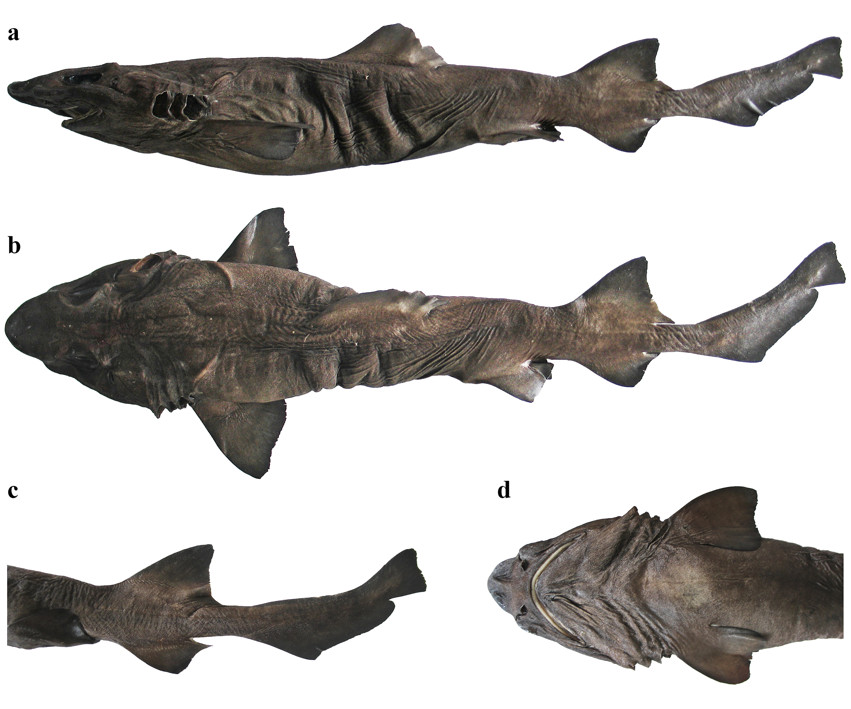Planonasus indicus
Ebert, Akhilesh & Weigmann, 2018
Classification: Elasmobranchii Carcharhiniformes Pseudotriakidae
Reference of the original description
Planonasus indicus sp. n., a new species of pygmy false catshark (Chondrichthyes: Carcharhiniformes: Pseudotriakidae), with a revised diagnosis of the genus and key to the family. Marine Biodiversity, 49(3), 1321–1341
Planonasus indicus sp. n., a new species of pygmy false catshark (Chondrichthyes: Carcharhiniformes: Pseudotriakidae), with a revised diagnosis of the genus and key to the family. Marine Biodiversity, 49(3), 1321–1341
Description :
Citation: Planonasus indicus Ebert, Akhilesh & Weigmann, 2018: In: Database of modern sharks, rays and chimaeras, www.shark-references.com, World Wide Web electronic publication, Version 04/2024
Please send your images of "Planonasus indicus" to info@shark-references.com

Planonasus indicus Ebert, Akhilesh &Weigmann, 2018, holotype, CMFRI GA.1.1.14.8, 630 mm TL, female, prior to preservation: a total lateral view, b total dorsal view, c second dorsal, pelvic, anal, and caudal fins in lateral view, and d ventral view of head and pectoral fins © used with permission by Dave Ebert, in: Ebert, Akhilesh &Weigmann, 2018, Planonasus indicus sp. n, a new species of pygmy false catshark (Chondrichthyes: Carcharhiniformes: Pseudotriakidae), with a revised diagnosis of the genus and key to the family. Marine Biodiversity, in press

Planonasus indicus Ebert, Akhilesh &Weigmann, 2018, holotype, CMFRI GA.1.1.14.8, 630 mm TL, female, prior to preservation: a total lateral view, b total dorsal view, c second dorsal, pelvic, anal, and caudal fins in lateral view, and d ventral view of head and pectoral fins © used with permission by Dave Ebert, in: Ebert, Akhilesh &Weigmann, 2018, Planonasus indicus sp. n, a new species of pygmy false catshark (Chondrichthyes: Carcharhiniformes: Pseudotriakidae), with a revised diagnosis of the genus and key to the family. Marine Biodiversity, in press
Common names
 Eastern Dwarf False Catshark
Eastern Dwarf False Catshark
 Eastern Dwarf False Catshark
Eastern Dwarf False Catshark
Short Description
Original diagnose after EBERT, AKHILESH & WEIGMANN, 2018 [26459]: A small deep-sea shark distinguished from its closest congener P. parini by the absence of oral papillae on the roof, tongue, and floor of mouth, lack of a distinct white mark on the free rear tip of the first dorsal fin, sides, and underside of head, as well as fin edges that are similar in color as body (vs. dusky), more tooth rows in the lower jaw (about 153–156 vs. about 115–120), shorter upper labial furrows (0.6–0.8 vs. 0.9– 1.2% TL and 0.7 vs. 1.0–1.2 times as long as lowers), longer (1.6 vs. 0.9–1.2% TL) and less high (0.8–0.9 vs. 1.2–1.8% TL) spiracles, proportionally higher, more angular dorsal fins, especially the second dorsal fin, proportionally longer pectoral fins, a proportionally larger anal fin, longer precaudal (79.4– 79.7 vs. 74.6–79.1% TL), pre-second-dorsal (62.7 vs. 56.6–60.5% TL), pre-first-dorsal (36.5–37.0 vs. 34.5–36.5% TL), prepelvic (52.7–53.4 vs. 47.2–51.4% TL), and snout-anterior vent (56.1–57.1 vs. 50.7–53.9% TL) lengths, and shorter distances for preorbital snout (7.3–7.7 vs. 8.3–8.5% TL), prepectoral length (22.7–23.0 vs. 24.0–25.4% TL), pelvic midpoint to second dorsal fin origin (4.8–5.6 vs. 5.6–7.7% TL), and pelvic-anal space (4.8–5.2 vs. 5.5–5.8% TL).
Original diagnose after EBERT, AKHILESH & WEIGMANN, 2018 [26459]: A small deep-sea shark distinguished from its closest congener P. parini by the absence of oral papillae on the roof, tongue, and floor of mouth, lack of a distinct white mark on the free rear tip of the first dorsal fin, sides, and underside of head, as well as fin edges that are similar in color as body (vs. dusky), more tooth rows in the lower jaw (about 153–156 vs. about 115–120), shorter upper labial furrows (0.6–0.8 vs. 0.9– 1.2% TL and 0.7 vs. 1.0–1.2 times as long as lowers), longer (1.6 vs. 0.9–1.2% TL) and less high (0.8–0.9 vs. 1.2–1.8% TL) spiracles, proportionally higher, more angular dorsal fins, especially the second dorsal fin, proportionally longer pectoral fins, a proportionally larger anal fin, longer precaudal (79.4– 79.7 vs. 74.6–79.1% TL), pre-second-dorsal (62.7 vs. 56.6–60.5% TL), pre-first-dorsal (36.5–37.0 vs. 34.5–36.5% TL), prepelvic (52.7–53.4 vs. 47.2–51.4% TL), and snout-anterior vent (56.1–57.1 vs. 50.7–53.9% TL) lengths, and shorter distances for preorbital snout (7.3–7.7 vs. 8.3–8.5% TL), prepectoral length (22.7–23.0 vs. 24.0–25.4% TL), pelvic midpoint to second dorsal fin origin (4.8–5.6 vs. 5.6–7.7% TL), and pelvic-anal space (4.8–5.2 vs. 5.5–5.8% TL).
Dentition
Teeth small, numerous, heterondonty strong between upper and lower teeth; upper teeth with single medial cusp flanked by a single smaller cusplet on either side; teeth arranged in about 122 (118) rows, with 5–6 teeth per row; teeth in medial most 4 rows (2 on each side of jaw symphysis) noticeably smaller than remainder of upper teeth. Lower teeth dignathic, arranged in about 156 (153) rows, with teeth in medial most 26 rows arranged in quincunx pavement pattern, with a single, large erect cusp, flanked on each side by 2 successively smaller cusplets, lateral tooth rows about 130, 65 on each side of jaw, lateral tooth shape becoming comb-like, with 3–5 cusps similar in height, median cusp about the same height or slightly higher; lateral and commissural teeth arranged in diagonal parallel rows, about 5–6 teeth per row. [26459]
Teeth small, numerous, heterondonty strong between upper and lower teeth; upper teeth with single medial cusp flanked by a single smaller cusplet on either side; teeth arranged in about 122 (118) rows, with 5–6 teeth per row; teeth in medial most 4 rows (2 on each side of jaw symphysis) noticeably smaller than remainder of upper teeth. Lower teeth dignathic, arranged in about 156 (153) rows, with teeth in medial most 26 rows arranged in quincunx pavement pattern, with a single, large erect cusp, flanked on each side by 2 successively smaller cusplets, lateral tooth rows about 130, 65 on each side of jaw, lateral tooth shape becoming comb-like, with 3–5 cusps similar in height, median cusp about the same height or slightly higher; lateral and commissural teeth arranged in diagonal parallel rows, about 5–6 teeth per row. [26459]
Remarks
shark-references Species-ID=15132;
shark-references Species-ID=15132;
















